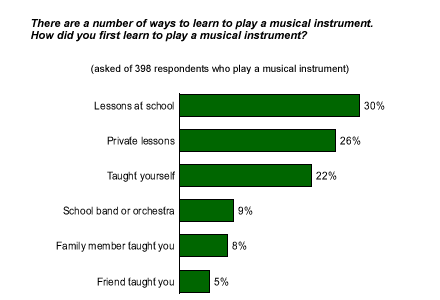With bagpipes playing and jazz trumpets blaring, a crowd of 500 arts supporters delivered a strong and creative message to the doorway of the New Jersey Senate Budget Committee last week as they began hearings to eliminate millions of dollars in arts education programs -- the arts are important to Americans.
And indeed they are. According to a recent Gallup Poll conducted for NAMM, the International Music Products Association*, 95% of Americans consider music to be part of a well-rounded education, and 93% feel that schools should offer music education as part of the regular curriculum. Nearly four in five (79%) even say that music education should be mandated for every student in school.
During times of economic difficulty, the arts, including music, are often among the first public education programs targeted for cuts. Now is one of those times. Nearly all state budgets are in fiscal crisis -- five states have budget gaps of $1 billion or more -- and education budgets will likely be hit hard with cuts in programs. According to the poll, the possibility of these cuts does not bode well for future musicians -- 30% of all respondents (aged 12 and older) who play a musical instrument told Gallup that they first learned to play by taking lessons in school, and another 9% said their first encounter with playing music was in a school band or orchestra. Roughly a quarter (26%) said they first learned with private lessons.

Who Plays Musical Instruments?
Overall, 37% of the respondents to this survey said they play a musical instrument. Although there are no differences between the percentages of men and women who play, it is interesting to note that twice as many women as men first learned to play through private lessons (35% vs. 17%, respectively), but that nearly three times as many men taught themselves to play, 33% vs. 12%.
While 82% of Americans who play an instrument began their musical training between the ages of 5 and 14, the joy of music endures long after the last school bell rings. In fact, 42% of those between the ages of 35 and 50 who learned to play an instrument still play, as well as 20% of people aged 50 and older. For some people, it's a lifelong pursuit. At 70, the great jazz trumpeter Louis Armstrong was going strong. He told his doctor just a few months before he died, "My whole life, my whole soul, my whole spirit is to blow that horn."
Social Benefits of Music
Certainly the benefits of music go beyond pure auditory delight. According to the poll, 85% of Americans believe that participating in a school music program correlates with better grades, and 80% feel that playing an instrument makes people smarter. Most parents probably wait until their babies arrive before introducing them to composers such as Debussy or Stravinsky, but 54% of Americans believe children should be exposed to music before their first birthday.
Bottom Line
It is clear that music is a valuable tool that brings joy to nearly all Americans. Now the U.S. Department of Education has given music (and art in general) its due. For the first time, the arts have been included as a "core academic subject" in the No Child Left Behind Act of 2001. That is good news for the long term, once the current budget crisis has passed. Now that the arts have been established as an equal contender with other subjects, music classes will be eligible for many federally funded programs earmarked for core curricula only. With adequate funding, music will remain an essential ingredient in every child's education for generations to come.
Plato, for one, would be thrilled to hear that 88% of Americans say that music is a very important part their lives. More than 2,000 years ago, he recognized music's value. "Music is a moral law," he said, "It gives a soul to the universe, wings to the mind, flight to the imagination, a charm to sadness, gaiety and life to everything."
*Findings are based on telephone interviews with 1,005 U.S. respondents, 12 years of age or older, conducted between Feb. 4 and March 8, 2003. For results based on the total sample, one can say with 95% confidence that the maximum margin of sampling error is ±3%.